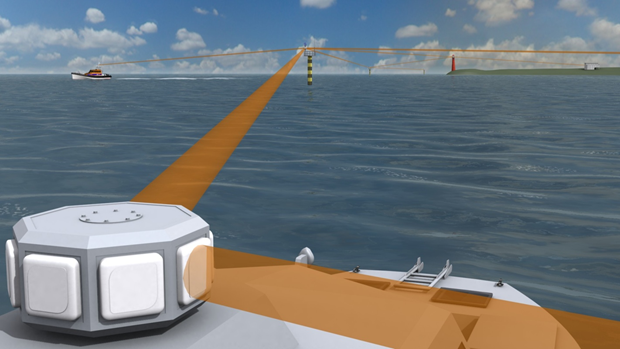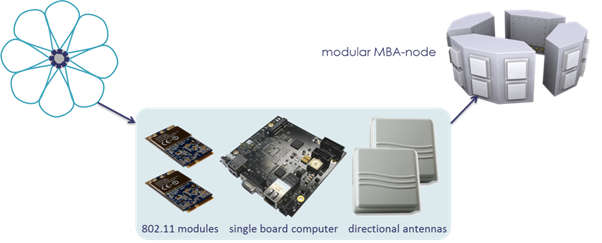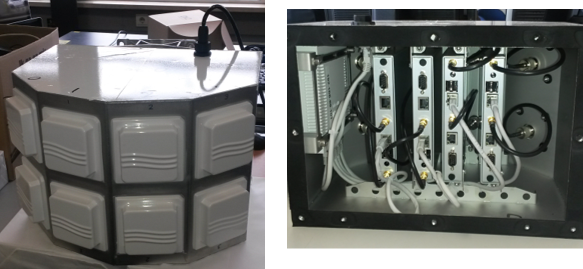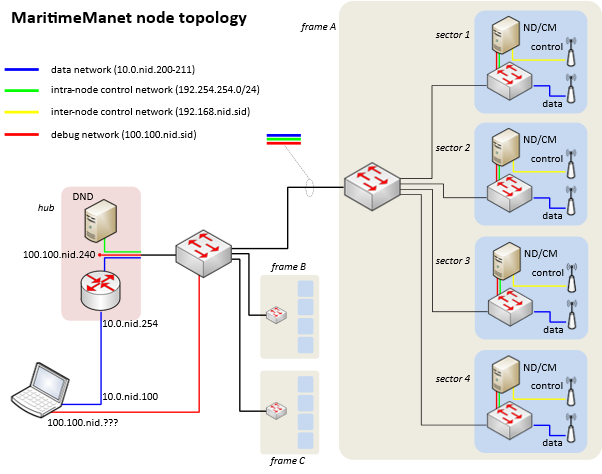Revitalizing the wireless network infrastructure for MaritimeManet

Mobile Ad-hoc Networking at Sea
Maritime organizations increasingly conduct operations at sea using multiple, possibly unmanned, platforms. An example for the Coast Guard is ‘distributed surveillance’ in which a large operational area is collectively inspected by unmanned surface vehicles (USV) and unmanned aerial vehicle (UAV), each carrying sensors with limited coverage. Video, image and data communication among those platforms is indispensable for such operations, while the distance between platforms at sea is generally relatively large. The maritime environment thus poses challenges for suitable communication within multi-platform systems.
MaritimeManet is an ad-hoc self-organizing wireless network that addresses these challenges. For radio communication, a MaritimeManet node uses a number of beams arranged in a sunflower pattern as shown left in Figure 1. The middle of the figure illustrates how each beam is created with state-of-the-art WiFi radio modules, a single board computer and a panel antenna to enable long distances transmission. The beams collectively cover all directions and thus enable communication in all directions. The resulting node, shown right in Figure 1, is called a Multi-Beam Antenna (MBA).
The fundamental principle in MaritimeManet is to automatically discover other nodes and to set up the strongest possible wireless connection between two nodes within radio reach by selecting the ‘best’ antenna at both nodes. To support connectivity while nodes move with respect to each other, MaritimeManet periodically selects the ‘best’ antenna at all nodes, which may result in handover of a connection to an adjacent antenna of a node. Movement of nodes may also lead to automatic removal of connections or to automatic creation of new connections.

Figure 1 – Composition of a single beam using commercial-off-the-shelf components.
Problem Statement:
MaritimeManet has been built some years ago at Thales for the first time. This first implementation has also been tested at sea [1]. The node implementation was based on PC Engines Alix/APU embedded computers with Atheros WiFi cards and directional antennas. These have all been integrated into a mechanical frame such that the antennas have the correct orientation w.r.t. each other. Figure 2 illustrates this initial implementation.

Figure 2 – First implementation of MaritimeManet.
Using these frames, a network node for experiments at sea has been configured. In this setup, all single board computers (ALIX, APU) and the MaritimeManet applications running on them can be controlled from a laptop. A full node, covering 360°, consists of three frames (see Figure 3).
Each frame consists of four segments, each covering 30°. Within a frame, the sectors are connected to a switch which provides the connectivity towards the hub. All three frames are connected to another switch that is also connected to the hub (see Figure 3). Also shown is a laptop per node that is connected to the switch. The latter is used to connect to all embedded computers in the system for configuration, logging and debugging purposes.
With two of such nodes, each consisting of at least one (1) frame, a wireless communication link can be setup. Once established, data can be exchanged over this link. For this purpose, the laptop is also connected to the router. A manual for conducting the tests at sea is given in [2].

Figure 3 – MaritimeManet node topology with three frames, each covering 120° azimuth.
Tasks:
All equipment used for the initial MaritimeManet implementation is available for research and experimentation at the PS group. Since we don’t know the current status of this equipment, and thus whether it can be used for follow-up research on MaritimeManet, this assignment addresses the revitalizing of this wireless infrastructure.
More specifically the student is expected:
- To check the correct operation of hardware and their power supplies
- To update the laptops to the latest version of Ubuntu
- To update the Alix and APU boards to the latest available version of OpenWRT [3,4]. It needs to be checked whether a precompiled version can be used or whether a custom-made version must be compiled.
- (re)configure all networks in the network infrastructure according to Figure 3
- To test if all networks and all embedded computers can be reached via the laptop.
- To check the correct operation of the network infrastructure by means of simple tests like Ping and iPerf
Work:
20% Theory, 60% Implementation and demonstration, 20% Writing
Contact:
Jan Laarhuis (j.h.laarhuis@utwente.nl)
Alessandro Chiumento (a.chiumento@utwente.nl)
References
[1] J.H. Laarhuis, ‘MaritimeManet – Breedband Netwerk op Zee’, eindrapport voor de Kustwacht, 2017 (in Dutch)
[2] J.H. Laarhuis, ‘Handleiding opstarten en configureren nodes’, TNL internal report, 2017 (in Dutch)
[3] OpenWRT page for PC-engines Alix, https://openwrt.org/toh/hwdata/pcengines/pcengines_alix2d2, accessed at March, 19, 2021
[3] OpenWRT page for PC-engines APU, https://openwrt.org/toh/hwdata/pcengines/pcengines_apu1c, accessed at March, 19, 2021
